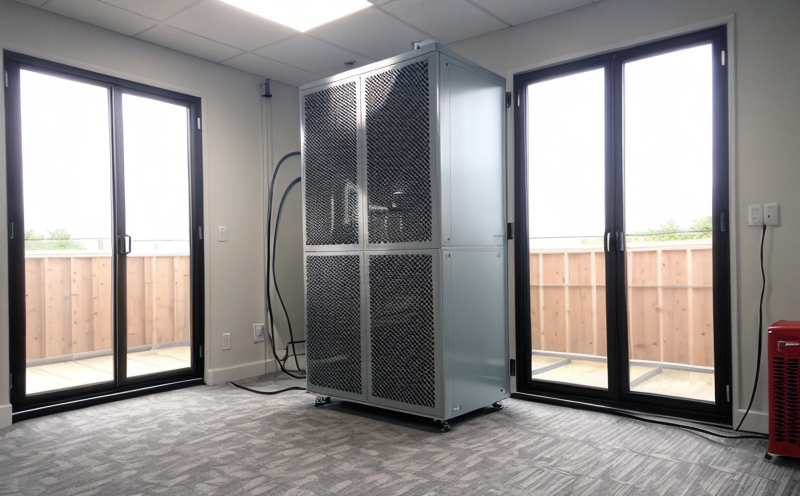ISO 29463 HEPA Filter Airflow and Efficiency
The ISO 29463 standard is a cornerstone in ensuring the integrity and performance of high-efficiency particulate air (HEPA) filters. This service focuses on the comprehensive testing of airflow and filtration efficiency, which are critical for maintaining clean environments in various sectors such as healthcare, pharmaceuticals, electronics manufacturing, and research facilities.
The process begins with selecting the appropriate test equipment that meets ISO 29463 requirements. Specimens undergo a series of rigorous tests to evaluate their ability to capture airborne particles. This includes both submicron and larger particulates, ensuring that the filter can handle real-world conditions effectively.
Once selected, the samples are prepared according to standard protocols. The testing apparatus typically consists of an air chamber through which known quantities of airflow pass over the filter under controlled conditions. The efficiency is determined by measuring the amount of particles present on both sides of the filter after it has been exposed to a specified particle challenge.
The test parameters include temperature, humidity, and pressure variations, all of which can affect filter performance. Real-world usage notes highlight that even slight deviations from these parameters can lead to significant differences in filtration efficiency. This underscores the importance of precise control during testing.
Upon completion of the tests, detailed reports are generated for each specimen. These reports provide quantitative data on airflow and filtration efficiency, along with graphical representations of test results. Compliance officers and quality managers rely heavily on these reports to ensure that their facilities meet stringent regulatory requirements.
The ISO 29463 standard ensures consistency across different labs by providing a clear set of guidelines for conducting these tests. This consistency is crucial in maintaining the integrity of cleanroom environments, which are critical in industries where even trace amounts of particulates can compromise product quality or patient safety.
In conclusion, adhering to ISO 29463 ensures that HEPA filters perform reliably and consistently across various applications. The testing process is meticulous, involving multiple steps from specimen preparation to final reporting, each designed to ensure the highest level of accuracy and reliability.
Applied Standards
The ISO 29463 standard is widely recognized for its comprehensive approach to HEPA filter testing. It specifies methods for determining airflow and efficiency under standardized conditions that are crucial for ensuring consistent performance across different applications.
The standard applies to a wide range of HEPA filters, including those used in medical facilities, semiconductor manufacturing, pharmaceutical production, and research laboratories. Compliance with ISO 29463 is mandatory in many countries where stringent air quality standards are enforced.
For instance, the healthcare sector relies heavily on ISO 29463 to ensure that HEPA filters meet the necessary efficiency levels to prevent airborne infections. Similarly, semiconductor manufacturing facilities use this standard to maintain particle-free environments essential for producing high-quality electronic components.
The pharmaceutical industry also benefits from ISO 29463 by ensuring that production areas are free from particulates that could contaminate products or affect patient safety. Research laboratories often employ these filters to protect sensitive experiments and equipment from contamination.
By adhering to the ISO 29463 standard, labs and facilities can demonstrate their commitment to maintaining high-quality air environments, which is essential for meeting regulatory requirements and ensuring product quality.
Industry Applications
| Industry | Application |
|---|---|
| Medical Facilities | Ensuring air quality in patient care areas to prevent airborne infections. |
| Semiconductor Manufacturing | Maintaining particle-free environments for producing high-quality electronic components. |
| Pharmaceutical Production | Protecting production areas from particulate contamination that could affect product quality or patient safety. |
| Research Laboratories | Preserving the integrity of experiments and equipment in environments free from contamination. |
| Hospitality | Maintaining air quality to enhance guest comfort and health. |
| Food and Beverage Processing | Avoiding particulate contamination that could lead to product spoilage or recalls. |
| Environmental Testing Labs | Evaluating the efficiency of filtration systems in various environmental conditions. |
The ISO 29463 standard is applicable across multiple industries, making it a versatile tool for ensuring consistent performance and reliability in HEPA filter testing. Its wide applicability underscores its importance in maintaining high-quality air environments crucial for numerous applications.
International Acceptance and Recognition
The ISO 29463 standard is internationally recognized and widely adopted by laboratories and facilities that require stringent HEPA filter testing. Its acceptance spans across various regions, including Europe (EN standards), North America (ASTM standards), and Asia-Pacific countries.
Many regulatory bodies around the world mandate compliance with this standard to ensure consistent quality in air filtration systems. For example, the European Union's Clean Air for Schools initiative recommends ISO 29463 as a benchmark for HEPA filter testing in educational facilities.
In North America, the U.S. Environmental Protection Agency (EPA) and Occupational Safety and Health Administration (OSHA) often reference ISO 29463 in their guidelines for maintaining cleanroom environments in industries such as pharmaceuticals and electronics manufacturing.
Similarly, Asian countries like Japan and South Korea have incorporated ISO 29463 into their national standards for air quality control. This global recognition highlights the standard's importance in ensuring consistent performance across different regions and industries.
The widespread acceptance of ISO 29463 underscores its role in maintaining high-quality air environments essential for various applications. By adhering to this standard, labs and facilities can demonstrate their commitment to meeting regulatory requirements and ensuring product quality.





